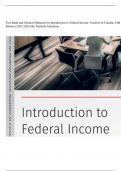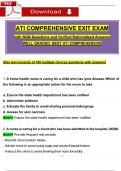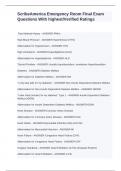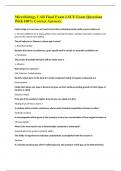Test Bank and Solution Manuals for Introduction to Federal Income Taxation in Canada, 44th
Edition (2023-2024) By Nathalie Johnstone
, CHAPTER 1
Introduction
Solution 1: Identify section of the Act
The following summary is discussed in more detail below:
Case Topic Part Division Subdivision Provision
(A) Person ..................................................... XVII — — subsection 248(1)
(B) Donation by individual............................ I E a subsection 118.1(3)
(C) Balance-due day...................................... XVII — — subsection 248(1)
(D) Life insurance premiums......................... I B a subsection 6(4)
(E) Capital dividend ...................................... I B h subsection 83(2)
(F) Income tax instalments for individual ..... I I — subsection 156(1)
(G) Qualified small business corporation share I C — subsection 110.6(1)
Reg. Part II,
(H) Information return for dividends ............. — — —
paragraph 201(1)(a)
(I) Definition of testamentary trust. ............. I B k subsection 108(1)
(J) Employee loan. ....................................... I B f subsection 80.4(1)
(K) Disposition of non-depreciable capital
property................................................... XVII — — subsection 248(1)
(L) RRSP administration fees. ...................... I B b paragraph 18(1)(u)
(M) Limit on deductible expenses.................. I B f section 67
Taxable dividends received by Canadian
(N) corporation .............................................. I C — subsection 112(1)
(O) RRSP excess contributions ..................... X.I — — subsection 204.1(1)
(A) Person — Part XVII, subsection 248(1): The term is used throughout the Act, so it is likely to be found
in the interpretation section. The definition is similar to many in the Act in that it does not tell you exactly what a
person is; it tells you what a person includes.
(B) Donation by an individual — Part I, Division E, Subdivision a, subsection 118.1(3): Tax credits are found
in Division E. Credits that are particular to individuals are found in Subdivision a of Division E.
(C) Balance-due day — Part XVII, subsection 248(1): The term has application to all tax filers and, therefore,
should be found in the interpretation section. However, the term has a different meaning depending on the type of
tax filer. For trusts and individuals, specific timing is provided. For corporations, the provision refers to section
157.
(D) Group term life insurance premiums paid by employer — Part I, Division B, Subdivision a,
subsection 6(4): Payments made on behalf of an employee by an employer likely result in income from
employment. Subdivision a includes the provisions for calculating income from employment.
(E) Capital dividend — Part XVII, subsection 248(1): The term is found in subsection 248(1) but a definition
is not actually provided, only a reference. It refers to another section — Part I, Division B, Subdivision h,
subsection 83(2): Capital dividends are tax-free distributions by a corporation to its shareholders, so the provision
is likely to be found in Part I, Division B, Subdivision h that deals with corporations and their shareholders.
(F) Income tax instalments for an individual — Part I, Division I, subsection 156(1): The information that is
required deals with payments to the CRA; therefore this information should be found in Division I dealing with
returns, assessments, payment and appeals. [Some students may also identify subsection 155(1) as dealing with
farmers and fishermen.]
(G) Qualified small business corporation share — Part I, Division C, subsection 110.6(1): The capital gains
deduction that is available for qualified small business corporation shares is a deduction that is available in
computing taxable income and is therefore found in Division C.
1
,
, 2 Introduction to Federal Income Taxation in Canada
(H) Filing information return for dividends paid — Regulations Part II, subsection 201(1): The Regulations
provide important detail regarding a number of the income tax rules. In order to ensure that individuals are advised
of the information required to be reported on their personal tax returns (and to allow the CRA to ensure that the
income is reported), corporations are required to file slips such as T5s for dividends paid.
(I) Testamentary trust — Part I, Division B, Subdivision k, subsection 108(1): The phrase describes a trust so
it is likely that the definition will be found in Subdivision k dealing with trusts. Section 108 contains definitions
for the subdivision.
(J) Interest-free loan benefit — Part I, Division B, Subdivision f, subsection 80.4(1): Since the amount relates
to an employee, it might be expected that the provision would be found in section 6 (in fact the provision that
requires an income inclusion is found in subsection 6(9)). However, the actual calculation of the amount of income
is found in Subdivision f which contains rules related to the calculation of income.
(K) Disposition of non-depreciable capital property — Part XVII, subsection 248(1): The term “disposition”
is used throughout the Act, so it is likely to be found in this definition section.
(L) Limit on deduction of RRSP administration fees — Part I, Division B, Subdivision b, paragraph 18(1)(u):
At one time, when the fees were deductible, they were considered a carrying charge deductible in computing
income from property. Therefore, the restriction on the deduction is found in section 18 which provides a list of
items that are specifically not deductible in computing income from business or property.
(M) Limit on deductible expenses — Part I, Division B, Subdivision f, section 67: The restriction on the
amount of deductible expenses applies throughout the Act. Therefore, the provision is found in general rules for
computing income that are found in Subdivision f.
(N) Corporate dividend deduction — Part I, Division C, subsection 112(1): The concept deals with a deduction
that is available to a corporation. It might be expected to be found in Division B, Subdivision b dealing with the
calculation of income from property. However, in this case, the deduction is not considered to reduce income from
property but is a general deduction available in computing taxable income.
(O) Excess RRSP contributions — Part X.I, subsection 204.1(1): This is a special tax that is found in the Act
and applies when an individual has contributed more to an RRSP than is allowed by the Act. In this case, the
special tax is intended to discourage people from taking advantage of the benefits of an RRSP beyond those that
are provided for in the rules.







